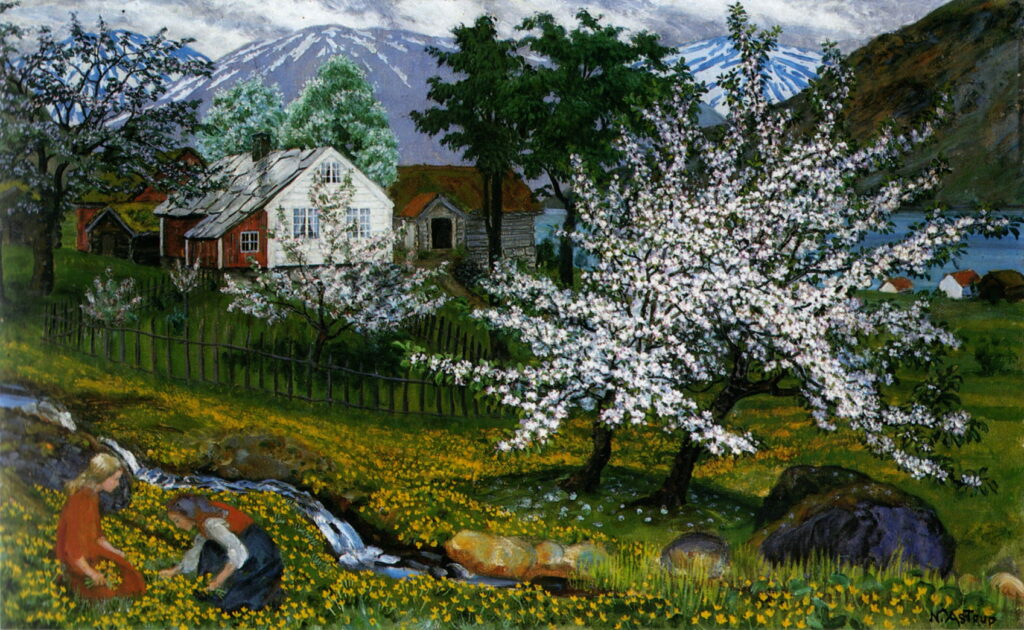Blossom festival 2024: 20th century

Following their popularisation in the nineteenth century, paintings of the Spring blossom festival continued to flourish, reinforced perhaps by increasing urbanisation.
Willard Metcalf (1858–1925), Dogwood Blossoms (1906), oil on canvas, dimensions not known, Florence Griswold Museum, Old Lyme, CT. Wikimedia Commons.
For Willard Metcalf, Dogwood Blossoms (1906) also provide the opportunity to explore the shimmering effects of dappled light, and how it can break the forms of large boulders.
Pierre Bonnard (1867-1947), Early Spring (1908), oil on canvas, 87.6 x 132.1 cm, The Phillips Collection, Washington, DC. The Athenaeum.
Pierre Bonnard painted Early Spring in 1908, shortly after his return to France from a visit to North Africa. The children are probably close friends from the Terrasse family, who are enjoying their garden as it comes into bloom in the improving weather.
Pierre Bonnard (1867-1947), The Small House, Spring Evening (1909),oil on canvas, 50.8 x 61.5 cm, Private collection. The Athenaeum.
The Small House, Spring Evening is an unusual landscape painted by Bonnard in 1909. It offsets the rich blossom on the trees at the left against the plain wall of a house, seen in failing light.
József Rippl-Rónai (1861–1927), Sour Cherry Tree in Blossom (1909), oil on cardboard, 68 x 90 cm, Rippl-Ronai Museum, Kaposvár, Hungary. Wikimedia Commons.
József Rippl-Rónai was the founding father of modern painting in Hungary, and in 1909 painted this Sour Cherry Tree in Blossom, in which the flowers overwhelm the whole painting, just as they had for Samuel Palmer nearly eighty years earlier.
Georges Clairin (1843–1919), On the Balcony (c 1910), oil on canvas, 110.8 × 94.9 cm, location not known. Wikimedia Commons.
One of the eclectic Georges Clairin’s later paintings from about 1910 brings an elegant group out among lush blossoms On the Balcony.
John William Waterhouse (1849–1917), A Song of Springtime (1913), oil on canvas, 71.5 x 92.4 cm, Private collection. Wikimedia Commons.
John William Waterhouse’s A Song of Springtime from 1913 has lost much of the narrative from more classical accounts of Flora and the Spring, but still features plenty of cherry blossom. Flora appears with her breasts bared, and a skirtful of daffodils or narcissi, perhaps a cross-reference to Poussin’s figure of Narcissus in his Empire of Flora. The Graces of old have been replaced by young children.
Helen Hyde (1868–1919), Blossom Time in Tokyo (1914), colour woodcut print, dimensions not known, Library of Congress, Washington, DC. Wikimedia Commons.
By the First World War, Western artists weren’t just collecting and studying the art of south-east Asia, but some went to live in countries such as Japan. Among these was the American printmaker Helen Hyde, who mastered the making of colour woodcut prints as in her Blossom Time in Tokyo, from 1914. This shows the tea ceremony taking place during the Spring viewing of blossom.
Théo van Rysselberghe (1862–1926), Almond Trees in Blossom (Morning) (1918), oil on canvas, 46.5 x 65 cm, Private collection. WikiArt.
By the end of the war, Théo van Rysselberghe’s colours had become as strong as those of the Fauves. In Almond Trees in Blossom (Morning) the more delicate pinks of the flowers pale in comparison with his full reds and blues, even down to the blue horse pulling a plough.
Mykhaylo Berkos (1861–1919), Apple Tree in Blossom (1919), oil on wood, 23.5 x 43.8 cm, location not known. Image by Leonid Kulikov or Mykhailo Kvitka, via Wikimedia Commons.
The Ukrainian artist Mykhaylo Berkos painted this classic Impressionist motif of an Apple Tree in Blossom in 1919. But this was to be his last Spring, as he died of typhus just before Christmas that year, at the age of only 58.
Nikolai Astrup (1880–1928), Apple Trees in Bloom (after 1920), oil on canvas, 54 x 88 cm, Private collection. Wikimedia Commons.
In the far north of Europe, the Norwegian Nikolai Astrup made blossom a part of many of his paintings of Spring and early summer in the fjords, as in his Apple Trees in Bloom, painted after 1920.
Nikolai Astrup (1880–1928), Apple Tree in Bloom (c 1927), oil on canvas, 78 x 100 cm, Bergen Kunstmuseum, KODE, Bergen, Norway. The Athenaeum.
In about 1927, Astrup painted Apple Tree in Bloom showing the trees in full blossom and marsh marigolds in flower.
Pierre Bonnard (1867-1947), The Open Door (c 1937), media not known, 126.1 x 71.1 cm, Private collection. The Athenaeum.
In Pierre Bonnard’s Open Door from about 1937, we look out through the frame of French windows to a table that has escaped into the landscape, and dazzles against brilliant blossom beyond. Isn’t this a glimpse not just of Spring, but of eternity?
Paul Nash (1892–1946), Battle of Britain (1941), oil on canvas, 122.6 x 183.5 cm, The Imperial War Museum, London. By courtesy of The Imperial War Museums © IWM (Art.IWM ART LD 1550).
Some blossom, though, isn’t to be celebrated but to be feared. For artists like the British Surrealist Paul Nash who went through two world wars, the appearance of white flowers in the sky was altogether more sinister. The skies had become the place of aerial warfare, and most of all the source of ‘white flowers’, parachutists, “that dreadful miracle of the sky blossoming with these floating flowers.”
I wish you a happy blossom festival, and above all peace under safe skies.
